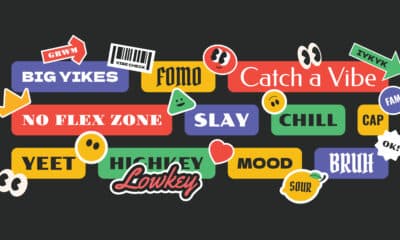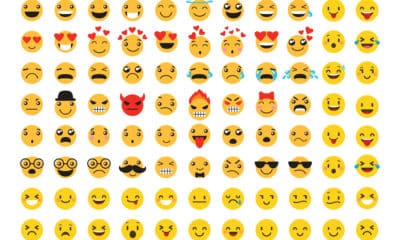When most Americans think of creativity, they think of LA, New York, and New Orleans. However, in today’s world, creativity isn’t limited to big-name cultural capitols. It’s happening anywhere, including cultural pop-ups like Jersey City and indie shops in the Midwest.
To determine where creative energy is most vibrant, we examined the cultural and artistic infrastructure in 150 of the nation’s largest cities. By measuring everything from museums and galleries to public art and theaters, this ranking reveals the places where creativity isn’t just surviving; it’s also transforming entire skylines, filling theaters, and emerging in unexpected places.
Key Findings:
- Jersey City, NJ, ranks as the most creative city in America.
- Seattle, WA, is the nation’s public art capital.
- Glendale, CA (population under 200,000) ranks in the Top 10 for museums, theaters, and overall creative density.
- Baltimore, MD, outshines larger Southern metros like Atlanta and Miami.
- Milwaukee, Minneapolis, and Des Moines all ranked as “underrated” overachievers, with far more creative spaces than expected for their size.
- Garden Grove, CA, and Tempe, AZ, show that small cities can pack a creative punch, each breaking into the Top 10 despite populations under 200K.
- Boston, MA, is one of the nation’s most balanced creative hubs.
- Tacoma, WA, emerges as Washington State’s rising star, thriving creatively in the shadow of Seattle.
- Nationally, public art and galleries drive local identity — cities that excelled in these areas often ranked higher overall, underscoring how creativity fuels both culture and community pride.
The Showstoppers: Top 10 Most Creative Cities in the U.S.
1. Jersey City, NJ: The Overachiever Next Door
Who needs Broadway when you’ve got Boardwalk?
Jersey City may sit in New York’s shadow, but its art scene shines on its own. The city has invested considerable energy in cultivating galleries, public artworks, and cultural spaces that reflect its diverse community and independent spirit.
With 251 galleries, 117 museums, and 455 public artworks squeezed into a compact area, Jersey City proves it’s not just a commuter hub, it’s a cultural powerhouse.
The motivation is clear: building a strong, local identity while giving residents and visitors a reason to look across the river for inspiration.
2. Glendale, CA: LA’s Understudy Stealing the Show
Glendale could have coasted as just another Los Angeles suburb, but instead it has leaned into the arts as a way to carve out its own stage. With 79 theaters and 150 public artworks, the city has become a surprising hub for culture and performance.
Glendale’s investment reflects a desire to balance proximity to Hollywood with a homegrown arts scene that lets residents enjoy creativity without getting caught in LA traffic.
3. Seattle, WA: The Tech City That’s Raining Murals
Seattle may be synonymous with tech giants and grunge music, but the city’s creative pulse runs just as strong in its art scene. With more than 1,200 public artworks woven into its streets (from towering sculptures to murals splashed across brick walls), Seattle treats creativity as an integral part of everyday life, rather than something confined to galleries.
For decades, the city has invested in making art accessible, believing that creativity should be a shared civic experience. That commitment has paid off: today, Seattle ranks among the top three most art-dense cities in the nation, a place where innovation and imagination meet on every corner.
4. St. Louis, MO: The Gateway to Creativity
Here, the arch isn’t the only thing that’s turning heads.
With 323 public artworks and 43 museums, the city has long treated art as a way to preserve history while sparking new ideas. Civic philanthropy and grassroots projects alike have kept creativity at the heart of the city’s identity, from the quirky City Museum to neighborhood murals that serve as community anchors.
For St. Louis, art is both heritage, hope, and a way to bridge the past and the future.
5. Oakland, CA: The Bay Area’s Bold Canvas
In Oakland, the streets double as canvases.
With 408 public artworks and 48 galleries, its streets and walls tell stories of resilience, diversity, and pride. Oakland invests in creativity not just for tourism, but as a voice for its communities: a visual language that turns activism into art and art into identity.
In a region often overshadowed by San Francisco, Oakland reminds the Bay that culture is built from the ground up.
6. Tempe, AZ: The Young Up-and-Comer
This desert town is on a hot streak.
Tempe’s identity is fueled by Arizona State University, and its arts scene reflects that youthful energy. With 163 public artworks and 30 galleries, the city treats creativity as both a campus asset and a community priority. Tempe invests in art to attract talent, support student creators, and build a reputation beyond being a college town.
The result is one of the Southwest’s densest art scenes, where murals, galleries, and installations keep pace with the desert sun.
7. Salt Lake City, UT: The Rocky Mountain Stage
Salt Lake City, UT: The Rocky Mountain Stage
With 179 public artworks and 37 theaters, the city has embraced creativity as a way to broaden its identity. Investments in theaters and public art reflect an effort to strike a balance between tradition and the demands of a younger, growing population.
For Salt Lake, the arts provide a stage where the city can showcase both its heritage and its evolving character.
8. Garden Grove, CA: The Drama Queen
This city loves the spotlight, and it shows.
Garden Grove might be modest in size, but it thrives on performance. With 48 theaters and 131 public artworks, the city has turned drama into its defining feature. Its investment in theater culture reflects a community that values storytelling, expression, and multicultural celebration.
Garden Grove proves that even small cities can create a big stage for creativity.
9. Santa Rosa, CA: More Art Than Wine
Sip, swirl, and stroll the murals.
Santa Rosa sits in the heart of wine country, but it has cultivated an arts scene that stands on its own. With 156 public artworks and 9 galleries, the city utilizes creativity to complement its vineyards and attract visitors seeking more than just tastings.
Santa Rosa’s motivation is to diversify tourism, celebrate local voices, and make art as much a part of the landscape as the vines.
10. Baltimore, MD: The Grassroots Giant
Charm City’s secret charm? 462 public artworks.
Baltimore’s creative strength has always been community-driven. With 462 public artworks, 57 museums, and 44 theaters, the city treats art as both an expression and a means of revitalization.
Grassroots murals double as neighborhood pride projects, while institutions anchor their cultural credibility. Baltimore invests in creativity because it understands art’s role in resilience as a way to turn grit into greatness.
Outpacing the Giants: Big Cities That Pack a Surprisingly Small Punch
When you think of creativity, your mind jumps to New York, Los Angeles, or Chicago. They have world-famous museums, theaters, and art districts. The surprise comes when you measure creativity per capita, because smaller cities are the ones that shine.
- New York City may be home to the Met and MoMA, but with 504 venues spread across millions of people, its density looks modest compared to Jersey City right across the river. Sometimes the understudy outshines the star.
- Los Angeles dazzles with Hollywood glitz, yet with 507 cultural spaces, its per-capita creativity falls behind neighbors like Glendale. This shows that creativity is not only about scale, but also about concentration.
- Chicago and Philadelphia boast hundreds of museums and galleries, but on a per-person basis, they get upstaged by Midwestern peers like St. Louis and Milwaukee. The heartland has plenty of creative energy.
- Denver stands out with 538 cultural venues, but smaller cities like Tempe and Garden Grove are notable for their denser creative footprints.
The big names still have vibrant art scenes. What the data reveals is that America’s smaller cities prove you do not need a massive population to make a massive cultural impact.
Small Cities, Huge Creativity
Big cities aren’t the only creative powerhouses.
These smaller metros, with populations under 300k, prove that vibrant cultural ecosystems can flourish without massive populations, making them some of the “pound-for-pound” leaders of creativity in America.
- Glendale, CA — 337 cultural spaces | pop. 187,823 | per capita: 0.0018 Glendale consistently shows up across categories, proving that size isn’t everything.
- St. Louis, MO — 418 cultural spaces | pop. 279,695 | per capita: 0.0015 St. Louis blends heritage institutions with grassroots arts initiatives.
- Tempe, AZ — 240 cultural spaces | pop. 190,114 | per capita: 0.0013 Fueled by Arizona State University, Tempe’s arts footprint is impressive for its size.
- Salt Lake City, UT — 256 cultural spaces | pop. 217,783 | per capita: 0.0012 Known for its natural beauty, Salt Lake also thrives as a creative hub.
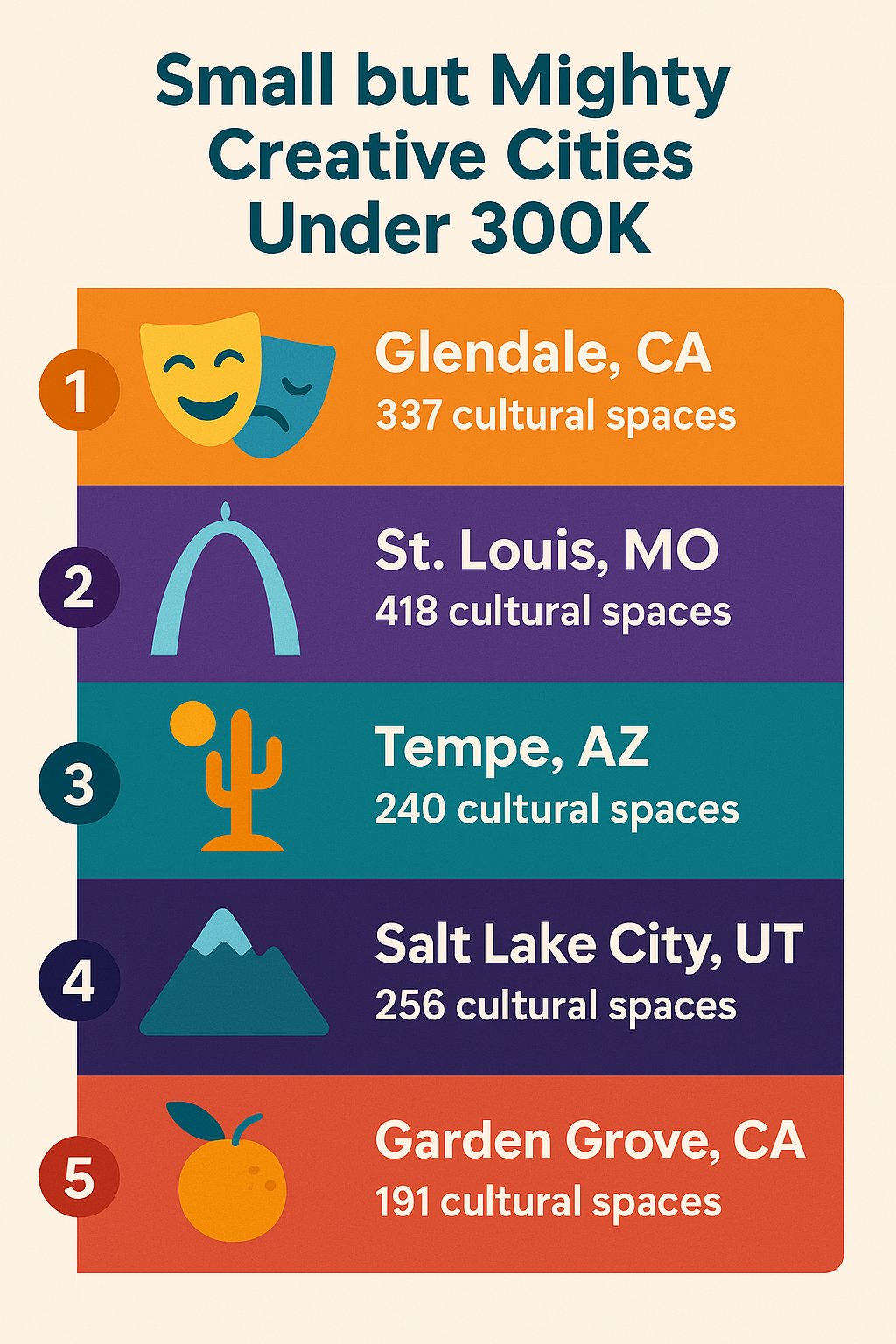
Small but Mighty Creative Cities
- Garden Grove, CA — 191 cultural spaces | pop. 172,361 | per capita: 0.0011 Garden Grove shines as another Southern California city with a high density of theaters and public art.
Scene Stealers: America’s Most Underrated Creative Cities
Some cities may not top the charts for overall creative density, but they stand out for outperforming expectations. These five cities offer far more cultural spaces than their size or reputation would suggest, making them hidden gems of American creativity.
While the Top 10 list highlights cities with the highest overall density of creative spaces, this list focuses on places that outperform expectations for their size. By looking at the measure of how much a city over- or under-indexes compared to the average, we uncovered the most underrated creative hubs that deliver more cultural impact than their population alone would suggest.
1. Boston, MA: More Than Just a High IQ
Brains and brushstrokes go hand in hand.
With 629 cultural spaces, including 89 museums, 85 theaters, and 387 public artworks, Boston proves it’s more than just a hub for history and higher education. Its cultural infrastructure makes it one of the East Coast’s most vibrant (and often underestimated) creative centers.
2. Milwaukee, WI: Beer, Baseball… and Art
Culture is brewing here in more ways than one.
Milwaukee boasts 544 creative venues, ranging from 36 galleries to over 400 public artworks. While it may be best known for beer and baseball, its thriving arts community secures it a place among the Midwest’s top cultural overachievers.
3. Minneapolis, MN: Music, Theatre, and Art, Oh My!
Minneapolis blends music, theater, and public art into a dynamic mix. With 386 creative spaces, including 57 theaters and 248 public artworks, the city shows how creativity is fueling urban life in the Twin Cities.
4. Des Moines, IA: Small City, Big Reach
Here is proof that Iowa’s capital is more than cornfields.
Iowa’s capital surprises with 214 cultural venues packed into its community, including 30 theaters and 159 public artworks. For a city its size, Des Moines delivers one of the strongest arts footprints in the Midwest.
5. Tacoma, WA: Rising Star of Washington’s Arts Scene
Seattle may get the headlines, but Tacoma gets the murals.
In the shadow of Seattle, Tacoma holds its own with 222 creative spaces. With 24 theaters, 165 public artworks, and a growing gallery scene, it’s quickly emerging as one of the Pacific Northwest’s most authentic creative hubs.
The Most Instagrammable Cities: Where the Walls Do the Talking
Public art transforms ordinary spaces into cultural landmarks. From murals to sculptures, it shapes how residents experience their city and how visitors remember it.
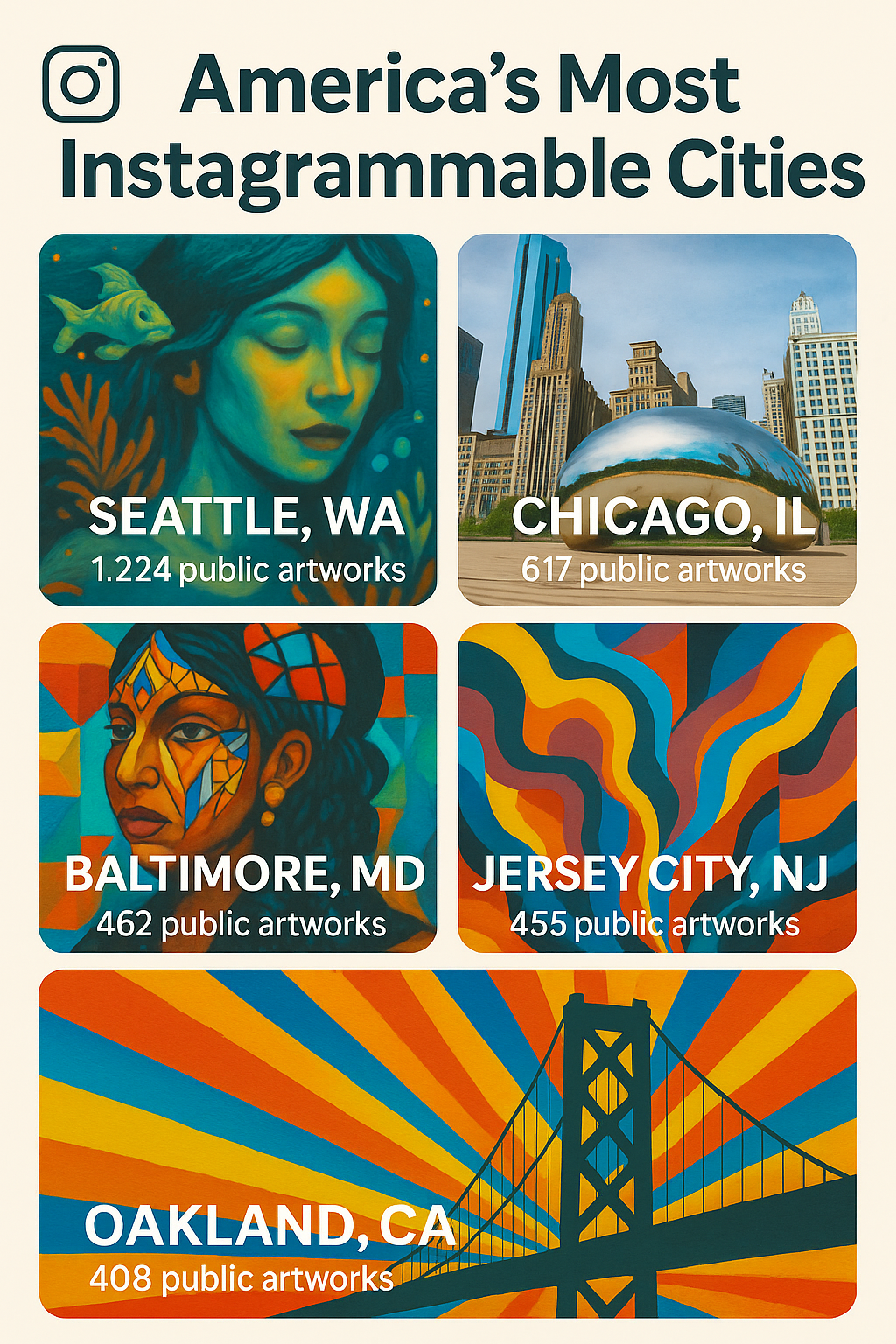
America's Most Instagrammable Cities
- Seattle, WA — 1,224 public artworks Seattle takes the top spot with more than double the installations of most cities in the top five, turning the city into an open-air gallery.
- Chicago, IL — 617 public artworks With iconic works like Millennium Park’s “Bean” and vibrant neighborhood murals, Chicago’s public art scene is a mix of global icons and local projects.
- Baltimore, MD — 462 public artworks Baltimore’s grassroots murals and community art projects reflect the city’s long tradition of self-expression and neighborhood identity.
- Jersey City, NJ — 455 public artworks Often overshadowed by New York, Jersey City boasts a dense and growing public art footprint that helps fuel its reputation as an independent cultural hub.
- Oakland, CA — 408 public artworks Oakland’s murals and installations highlight diversity, activism, and storytelling, making the city itself a living canvas.
The History Buff’s Bucket List
Museums anchor cultural tourism and connect communities with history, art, and science. Cities with high museum density often become hubs for school field trips, international visitors, and weekend explorers alike.
- Jersey City, NJ — 117 museums Jersey City tops the list, outpacing even many larger metros with a surprising depth of cultural institutions.
- Philadelphia, PA — 105 museums From the Liberty Bell to the Philadelphia Museum of Art, the city’s institutions blend history with world-class collections.
- Boston, MA — 89 museums Boston pairs its rich academic history with dozens of museums dedicated to art, science, and American heritage.
- Chicago, IL — 68 museums Anchored by the Art Institute and the Field Museum, Chicago’s museums attract millions of visitors annually.
- Glendale, CA — 66 museums Despite its modest size, Glendale’s strong lineup of museums helps it punch above its weight as a cultural destination
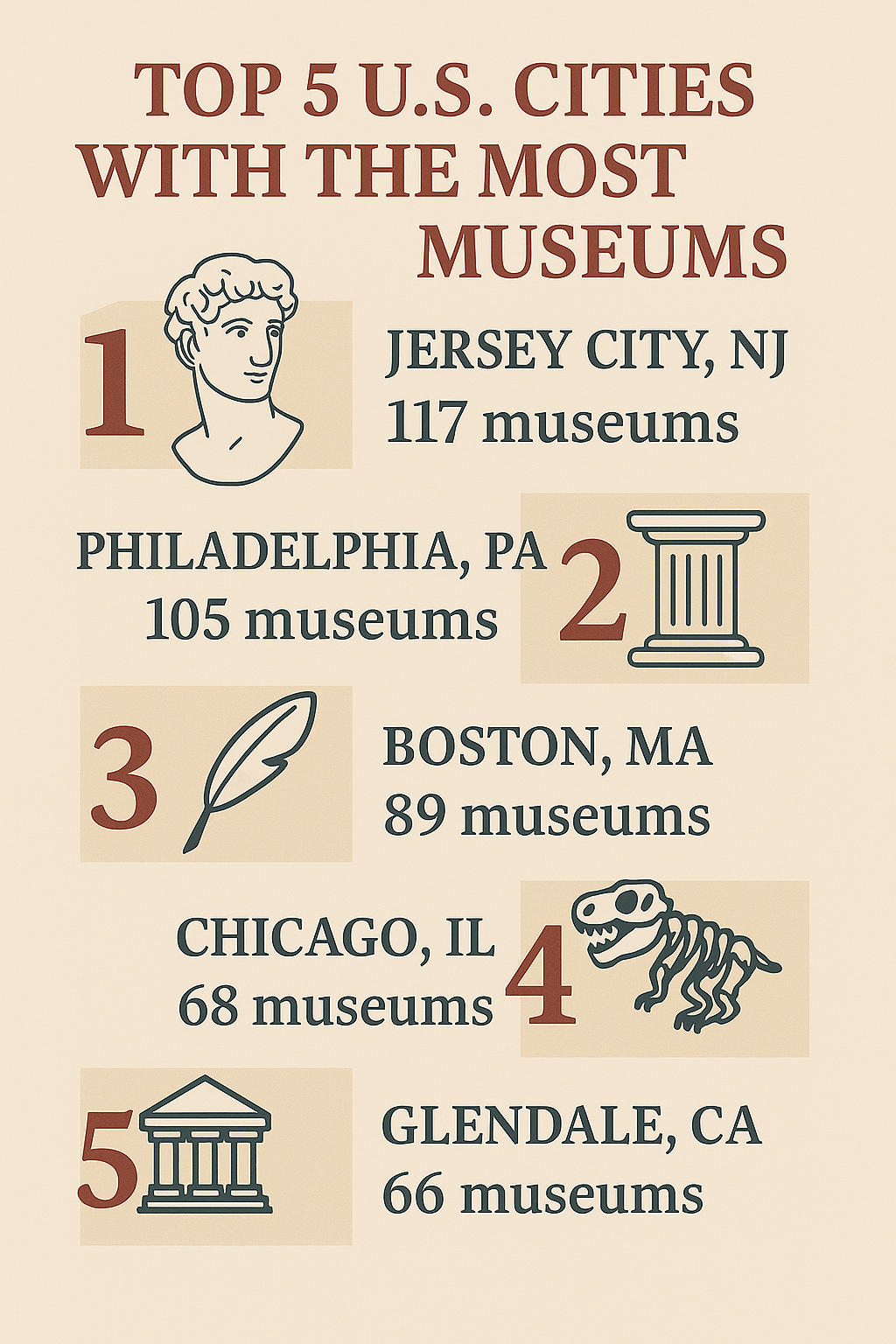
Top 5 U.S. Cities with the Most Museums
The Drama Capitals of America: All the World’s a Stage
The performing arts thrive in cities with dense theater networks, creating opportunities for both local productions and touring shows. Beyond Broadway, these five cities prove that the stage is alive across the country.
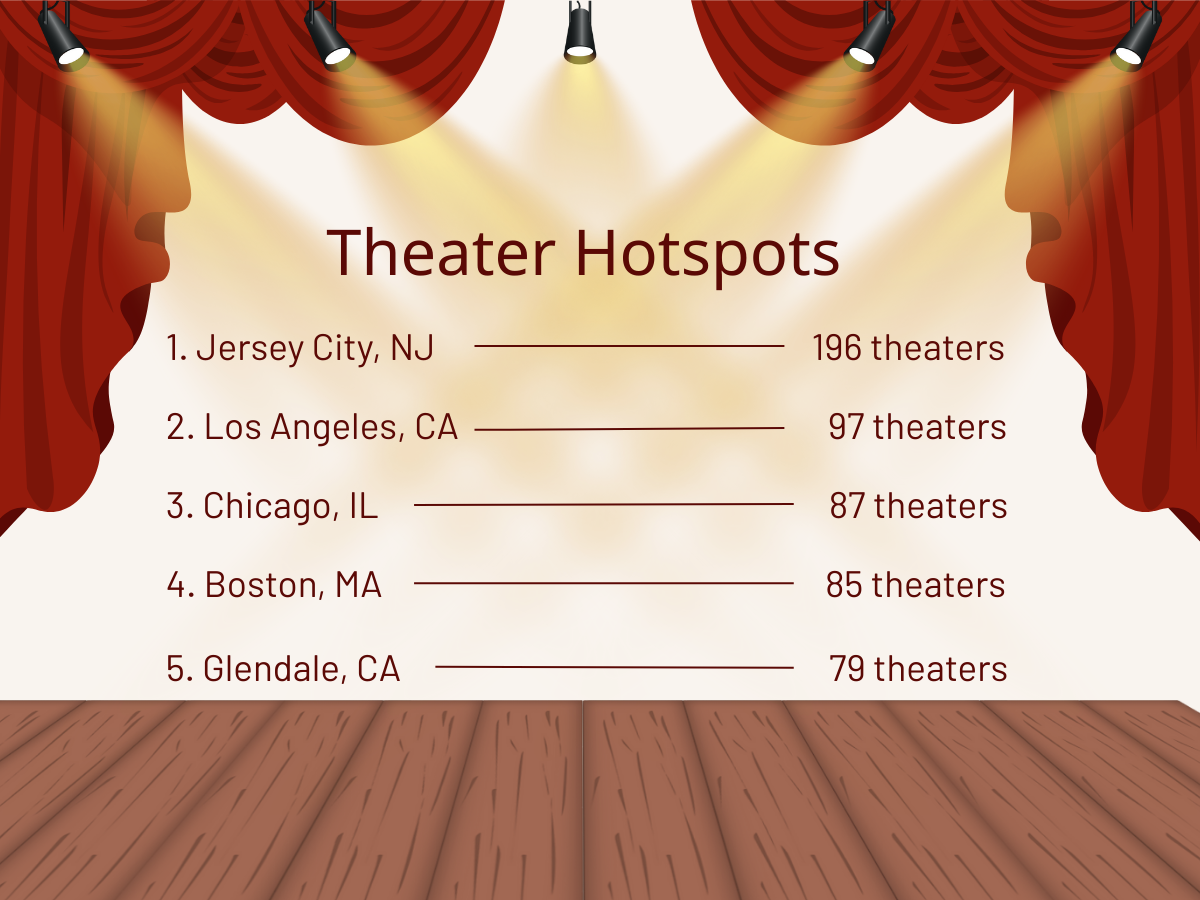
Theater Hotspots
- Jersey City, NJ — 196 theaters Nearly 200 theaters make Jersey City a performing arts powerhouse, giving it more venues than many larger U.S. cities.
- Los Angeles, CA — 97 theaters Known for Hollywood, Los Angeles also boasts a thriving live performance culture across dozens of theaters.
- Chicago, IL — 87 theaters From improv to Shakespeare, Chicago’s theater scene is one of the most diverse in the country.
- Boston, MA — 85 theaters Boston’s long tradition of theater is reflected in its strong mix of historic playhouses and modern stages.
- Glendale, CA — 79 theaters Glendale again appears as an overachiever, with a theater density that rivals cultural heavyweights.
The Canvas Kingdoms: Cities Packed With Galleries
Galleries fuel the careers of independent artists, offering spaces to sell work, build networks, and attract collectors. These cities top the charts for gallery density, highlighting where independent creators thrive most.
- Jersey City, NJ — 251 galleries With more than 250 galleries, Jersey City’s creative ecosystem rivals nearby New York.
- New York, NY — 74 galleries Home to some of the world’s most famous galleries, New York continues to be a global art hub.
- Oakland, CA — 48 galleries Oakland’s gallery scene is known for supporting emerging and diverse voices.
- Denver, CO — 44 galleries Denver has become a cultural anchor for the Mountain West, with a gallery scene to match.
- Chicago, IL — 43 galleries From the River North district to neighborhood collectives, Chicago’s gallery landscape is broad and accessible.
Creativity as an Economic Engine
Creativity isn’t just about self-expression. It’s an economic force that shapes how cities grow and thrive. National research clearly shows that the nonprofit arts and culture sector generates $151.7 billion in annual economic activity, supporting 2.6 million jobs and providing more than $29 billion in government revenue. When residents and visitors engage with creative spaces, the ripple effect benefits restaurants, retail, and local makers.
Our analysis highlights how this plays out on the ground:
Tourism boost: Seattle doesn’t just have landmarks; it’s a landmark in itself. Studies have shown that public art can increase foot traffic and even enhance perceptions of safety in neighborhoods.
Business growth: Jersey City’s 251 galleries and 117 museums create steady demand for printers, design studios, and independent suppliers. Research has found that public art and cultural investment often attract outside investment and improve property values. For many artists and entrepreneurs, having access to custom printing services is what helps transform creative projects into products that can be sold or displayed.
Side hustle culture: Tempe, AZ, with 163 public artworks and 30 galleries, illustrates how smaller cities and university towns foster a growing creator economy, where students and residents turn passion projects into businesses. Affordable tools like poster printing or custom packaging make it possible to launch a brand from a dorm room, garage, or a kitchen studio.
Urban revitalization: In these cities, murals don’t just color walls; they color entire neighborhoods with new life. Baltimore’s 462 public artworks and 57 museums have played a central role in neighborhood revitalization. National research confirms that public art contributes to placemaking, supports local development, and drives community pride.
Summary
Our latest Digital PR campaign, America’s Most Creative Cities Ranked in 2025, uncovers surprising cultural powerhouses across the U.S., proving creativity isn’t confined to New York, LA, or New Orleans. By analyzing 150 of the nation’s largest cities based on galleries, theaters, museums, and public art, the study highlights unexpected leaders like Jersey City, Glendale, Tempe, and Tacoma, alongside established hubs like Seattle, Boston, and Oakland. The findings reveal how smaller and mid-sized cities are redefining America’s creative landscape, showing that vibrant cultural ecosystems thrive everywhere — driving community pride, economic growth, and fresh opportunities for local creators.
Methodology
To uncover America’s “Unexpectedly Creative Cities,” we analyzed OpenStreetMap (OSM) data for 150 of the largest U.S. cities. We measured the density of cultural and creative spaces — including museums, art galleries, theaters, arts centers, and public artworks — within a fixed 15 km radius around each city center.
Because many city boundaries overlap, we applied a nearest-city assignment: each location was attributed to the closest city center within 20 km to prevent double-counting. We then normalized the results by population (U.S. Census, 2023 estimates) to calculate a per-capita “creative score” for each city. Finally, we compared observed creative density against expected values (based on city population size) to identify which places outperform expectations.
Fair Use
Users are welcome to utilize the insights and findings from this study for noncommercial purposes, such as academic research, educational presentations, and personal reference. When referencing or citing this article, please ensure proper attribution to maintain the integrity of the research. Direct linking to this article is permissible, and access to the original source of information is encouraged.
For commercial use or publication purposes, including but not limited to media outlets, websites, and promotional materials, please contact the authors for permission and licensing details. We appreciate your respect for intellectual property rights and adherence to ethical citation practices. Thank you for your interest in our research.

